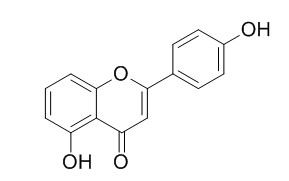4',5-Dihydroxyflavone
4',5-Dihydroxyflavone is a soybean LOX-1 and yeast α-Glucosidase inhibitor, with an Ki of 102.6 μM for soybean LOX-1 and an IC50 of 66 μM for yeast α-glucosidase.
Inquire / Order:
manager@chemfaces.com
Technical Inquiries:
service@chemfaces.com
Tel:
+86-27-84237783
Fax:
+86-27-84254680
Address:
1 Building, No. 83, CheCheng Rd., Wuhan Economic and Technological Development Zone, Wuhan, Hubei 430056, PRC
Providing storage is as stated on the product vial and the vial is kept tightly sealed, the product can be stored for up to
24 months(2-8C).
Wherever possible, you should prepare and use solutions on the same day. However, if you need to make up stock solutions in advance, we recommend that you store the solution as aliquots in tightly sealed vials at -20C. Generally, these will be useable for up to two weeks. Before use, and prior to opening the vial we recommend that you allow your product to equilibrate to room temperature for at least 1 hour.
Need more advice on solubility, usage and handling? Please email to: service@chemfaces.com
The packaging of the product may have turned upside down during transportation, resulting in the natural compounds adhering to the neck or cap of the vial. take the vial out of its packaging and gently shake to let the compounds fall to the bottom of the vial. for liquid products, centrifuge at 200-500 RPM to gather the liquid at the bottom of the vial. try to avoid loss or contamination during handling.
Applied Biological Chemistry2023, 66(58):112.
PLoS One.2021, 16(6):e0248479.
J Formos Med Assoc.2020, S0929-6646(20)30425-3
Front Microbiol.2022, 12:833233.
Nutrients.2021, 13(10):3414.
Asian Pac J Cancer Prev.2019, 20(1):65-72
Appl. Sci.2025, 15(1), 247
J.the Korean Socie. Food Sci.&Nut.2023; 52(1):26-39.
Int J Mol Sci.2019, 20(9):E2244
Microchemical Journal2023. 191:108938
Related and Featured Products
J Agric Food Chem. 2005 May 18;53(10):4258-63.
Human gut microbial degradation of flavonoids: structure-function relationships.[Pubmed:
15884869]
METHODS AND RESULTS:
The relationship between chemical structure and gut microbial degradation rates of 14 flavonoids, flavone, apigenin, chrysin, naringenin, kaempferol, genistein, daidzein, daidzin, puerarin, 7,4'-dihydroxyflavone, 6,4'-dihydroxyflavone, 5,4'-dihydroxyflavone(4',5-Dihydroxyflavone), 5,3'-dihydroxyflavone, and 4'-hydroxyflavone, was investigated by anaerobically fermenting the flavonoids with human gut microflora (n = 11 subjects). Degradation rates for the 5,7,4'-trihydroxyl flavonoids, apigenin, genistein, naringenin, and kaempferol, were significantly faster than the other structural motifs.
CONCLUSIONS:
Puerarin was resistant to degradation by the gut microflora. Extensive degradation of flavonoids by gut microflora may result in lower overall bioavailability than those flavonoids that are slowly degraded because rapidly degrading flavonoids are less likely to be absorbed intact.



